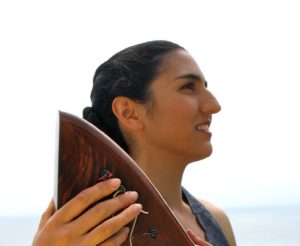This month I had the pleasure of speaking with Portia Diwa, Healing Harp Clinical Faculty at California Pacific Medical Center. She plays healing music for patients and teaches the Healing Harp Certification program for harpists who want to learn how to play at the bedside. Portia also directs the Harmony Harp Ensemble for children and the Healing Harp Ensemble for adults. She is on faculty for the Sound, Voice and Music Healing Certification Program at the California Institute for Integral Studies. Portia has performed both as a soloist and as a member of various ensembles.
Editor’s Note: This interview has been edited for length and clarity.
 Debra L. Stang: Hello, Portia. Thank you for taking the time to speak with me. How did you get interested in playing the harp?
Debra L. Stang: Hello, Portia. Thank you for taking the time to speak with me. How did you get interested in playing the harp?
Portia Diwa: It’s nice to talk with you, Debra. I’ve been playing the harp for 26 years, since I was 9 years old and saw another girl playing the harp. All of my friends were choosing instruments like the flute and the clarinet. I wanted something unique.
Debra: What started you on the path to playing healing music?
Portia: When I was 12 years old, my harp teacher, Diana Stork, asked me what I wanted to do with my harp playing. I was introverted by nature, so I didn’t see myself playing on stage. When I learned I could use my music for healing, I knew immediately that that was what I wanted to do. I started playing at nursing homes and hospitals. It was wonderful to bring music into the world with the purpose of helping other people feel good.
Debra: How did you decide to turn your harp therapy into a career?
Portia: I didn’t study harp in college because they didn’t have a music program that interested me. I majored in English instead. After I graduated, I did many odd jobs in the harpist world. Then I saw an advertisement for a job playing healing music through the Institute for Health & Healing in Marin. I became a certified harp therapist and went through a bedside harp certification program.
Debra: I’ve heard of music thanatology. Is that what you’re doing?
Portia: It’s actually a little different. Music thanatology is a form of therapy that involves using music to soothe and connect with people who are dying. The harp music I play is for people in any stage of the healing – or the dying – process.
 Debra: Where do you play your harp?
Debra: Where do you play your harp?
Portia: When I’m working with a patient, I go to his or her bedside. I have a small 26-string harp that my dad made for me. I’ve played in the intensive care unit, in the med/surg unit where people are recovering from operations, in the cardiac unit, the cancer ward, the transplant unit and wherever people are receiving palliative care. I also play in the hallways sometimes for the nursing staff. Often they will hear me play and realize that my services might be valuable for someone they’re taking care of. I usually speak to someone on the patient’s healthcare team before I offer the patient harp therapy. That’s one of the reasons why I like to play healing music for the nurses.
Please join us for part two of Portia’s interview next week.

 How Do You Use Healing Harp Music with a Seriously Ill Loved One?
How Do You Use Healing Harp Music with a Seriously Ill Loved One?


 The Other Death in the Family
The Other Death in the Family
















